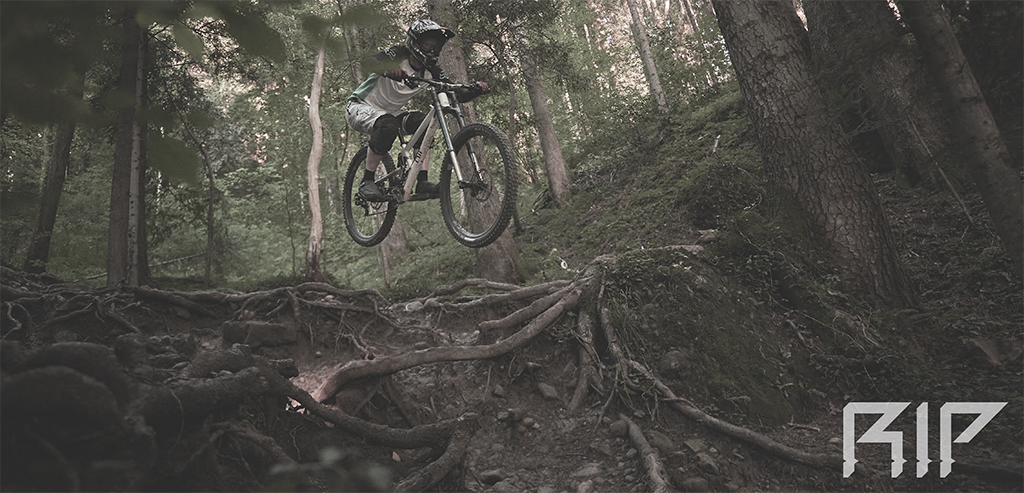
It all started around 2012 with the legendary Double Dragon RIP. Even then, the frame knew in its first version to convince and was much discussed in forums and on races. Now, about 10 years and several evolutionary stages later, the frame comes with many changes and even more attention to detail. For the whole story of the RIP and its developer, here is a story: History of RIP
But now to the facts: The RIP was developed as a thoroughbred DH race bike and its capabilities are uncompromisingly designed for chasing seconds between the tape. The developer Matthias Reichmann realizes with the RIP his own idea and his demands on a DH bike and lets his years of experience as a racer in national and international championships flow into the development.
Construction

The RIP frame is 100% made in Germany, welded and heat treated in Karlsruhe, the CNC milled parts come from Jonathan Debus Frästechnik in Diezhölztal, the turned parts come from Biberach. Final assembly, rework, special work is done by Matthias himself.
Calculation and CAD design are carried out by Matthias Reichmann himself. This is generation 4 of the RIP. It was built 12 times.
Adjustability

Wheel size: With the help of differently long links, the wheel size of the rear wheel can be compensated. Thus, the use of a 27.5 “or 29 “rear wheel is possible without changing the geometry.
Per custom lever is even the use of 27.5 “front and rear wheel possible. Since this option but rather rarely in demand, these levers are sold only on request.

Progression: The Ratio Control Link can be used to fine-tune the progression of the rear triangle. The change of the progression is made by a rotation of the link.

Chainstay length: The dropout of the RIP IV has three position for the rear wheel axle. This allows the chainstay length to be adjusted to 445, 455 or 465 mm depending on the route and personal preferences.
Rear end

Short Link Four-Bar
The rear triangle does not rotate around a fixed point but around an instant center. This instant center changes its position over the course of the spring travel whereby individual parameters of the kinematics can be very finely tuned. The main focus here is on the creation of a perfect progression curve.
Geometry
| S1 | S2 | |
| Reach | 450 mm | 500 mm |
| Stack | 636 mm | 636 mm |
| head angle | 62° | 62° |
| chainstay length | 445 – 455 – 465 mm | 445 – 455 – 465 mm |
| seat tube length | 380 mm | 380 mm |
| wheelbase | 1290 mm | 1340 mm |
| BB Drop | -32 mm | -32 mm |
| travel | 203 – 208 mm | 203 – 208 mm |
Kinematics

Leverage Ratio
The rear triangle generates 203 mm of travel from 76 mm of shock stroke.
The progression increases relatively constantly over the first 80% of the travel. Towards the end of the travel, the progression increases very sharply and thus prevents the shock from rough g-outs. In practice, this is noticeable via a very fine response behavior at the beginning of the travel. This fine response continues over a wide part of the travel, while the last 10% of the travel is very tight.
If the ratio control link is turned, the middle range of the progression becomes somewhat flatter and sets in later at the end of the travel. The bike is therefore a little tighter at the beginning of the travel, but offers a little more support in the middle range of travel.

Anti Rise
The Anti Rise ensures that the shock does not compress or decompress too much due to the braking forces introduced into the rear triangle.
In the mid-travel range, the anti-rise is about 80% which keeps the suspension active under braking influences, but the rear end does not compress too much during braking.

Pedal Kickback
The pedal kickback is in a low range in the mid-travel range and thus has little influence on the rear suspension.

Anti Squat
The Anti Squat counteracts the inertia caused by acceleration and thus a bobbing of the shock during pedaling.
With the RIP IV, the anti-squat in the SAG range is 140%. The shock is thus slightly pulled apart when pedaling and gives the bike in sprints or pedaling passages a sporty tight character and prevents a bobbing of the shock by the pedaling movements.
Towards the end of the travel, the Anti Squat decreases rapidly. This allows a fine response of the suspension in the last part of the travel despite the high progression in this area and at the same time counteracts a high pedal kickback during strong compressions.
Frame interfaces
| recommended travel fork | 200 mm |
| bottom bracket | BSA 83 mm |
| head tube | ZS 56 / ZS 56 |
| shock length / shock stroke | 241 / 76 mm |
| shock installation width front | 22 mm |
| shock installation width rear | 22 mm |
| rear brake mount | IS 2000 |
| max Ø brake disc | 230 mm |
| inner-Ø seat tube | 30.9 mm |
| outer-Ø seat tube | 34.9 mm |
| max tyre width | 2.6″ / 70 mm |
| wheel size | 29″/29″ or 29″/27,5″ |
| ISCG | ISCG05 |
| installation width rear wheel | 150 x 12 mm |
